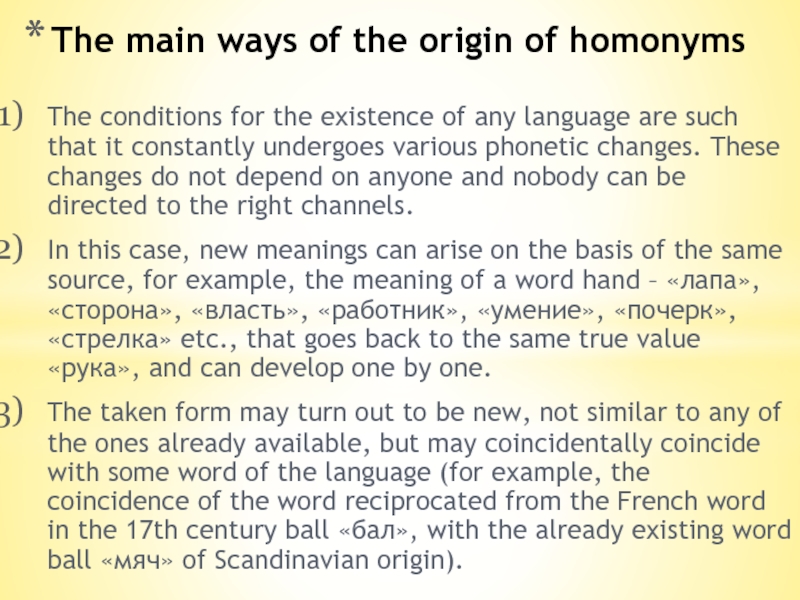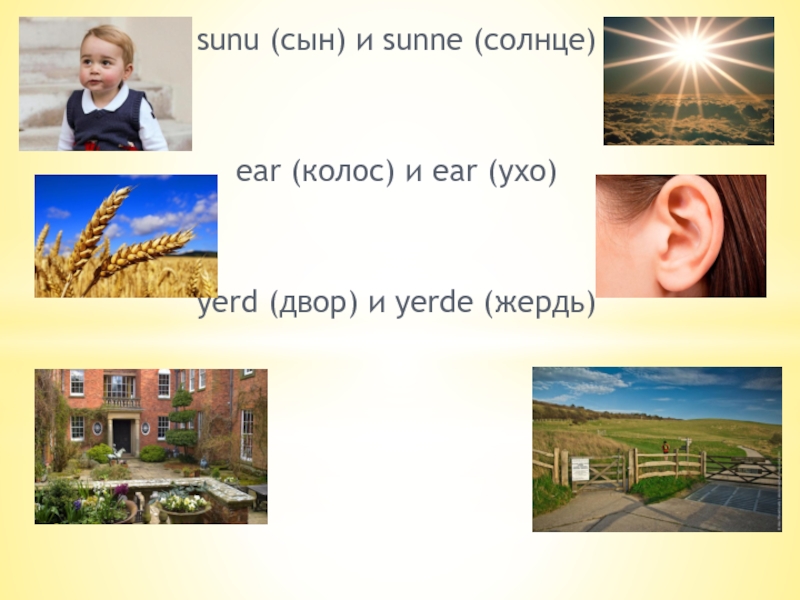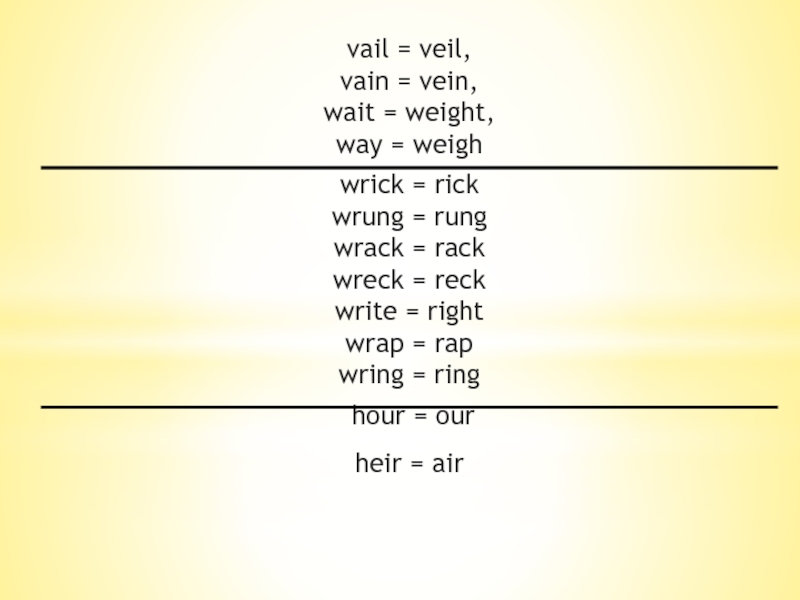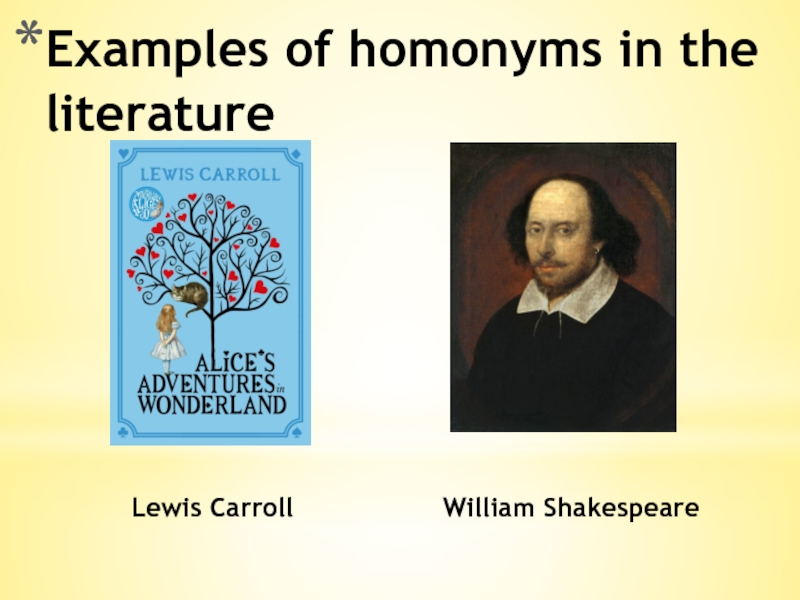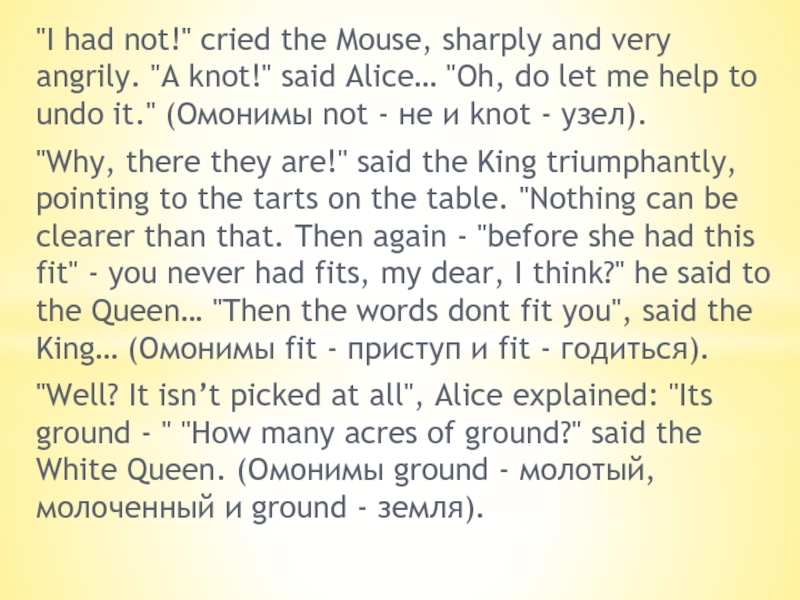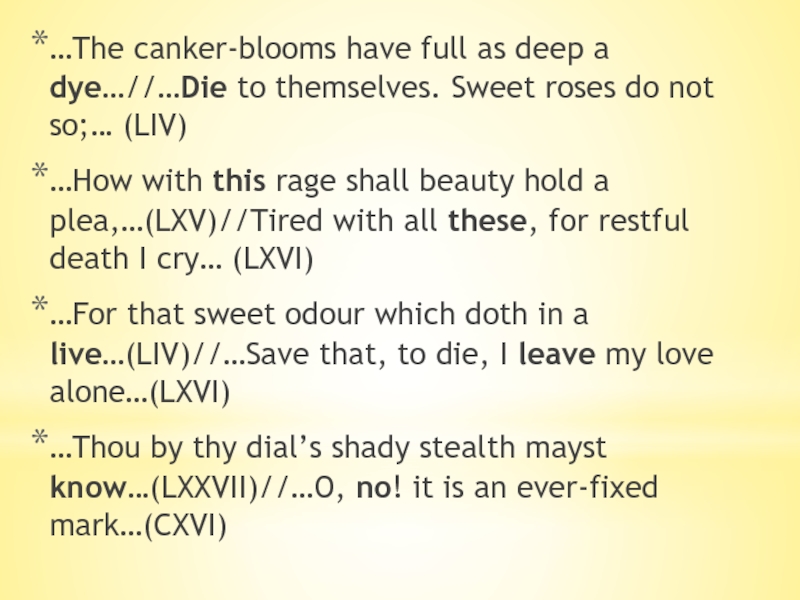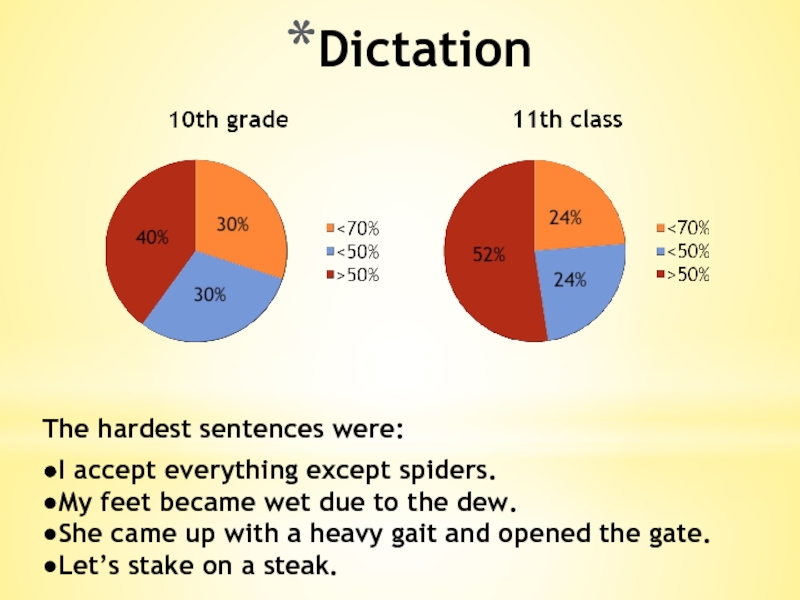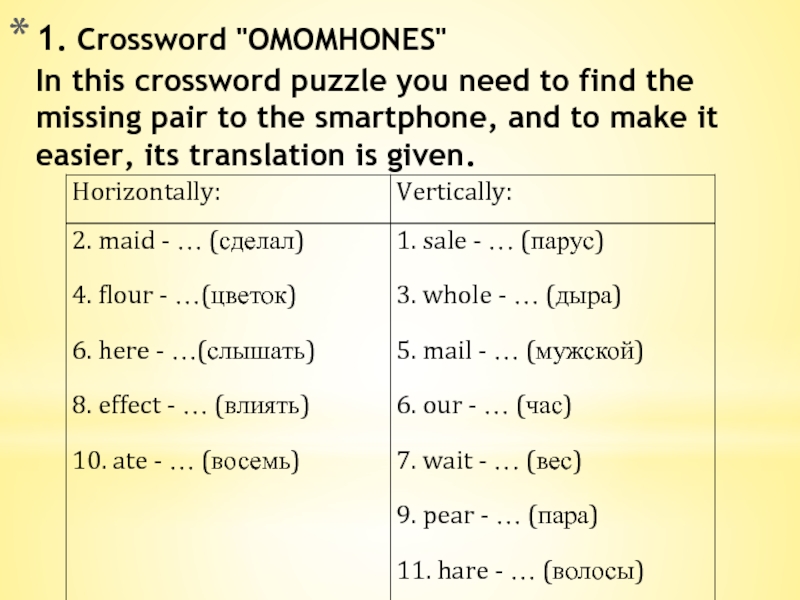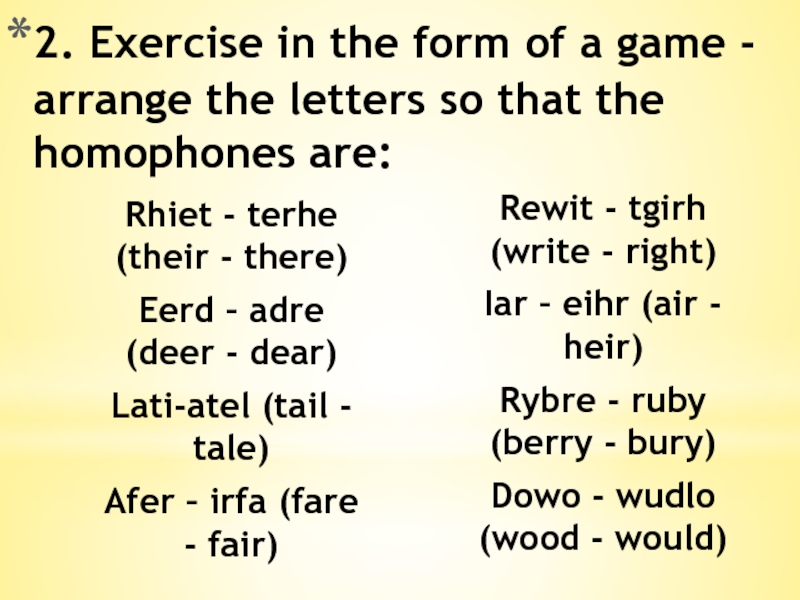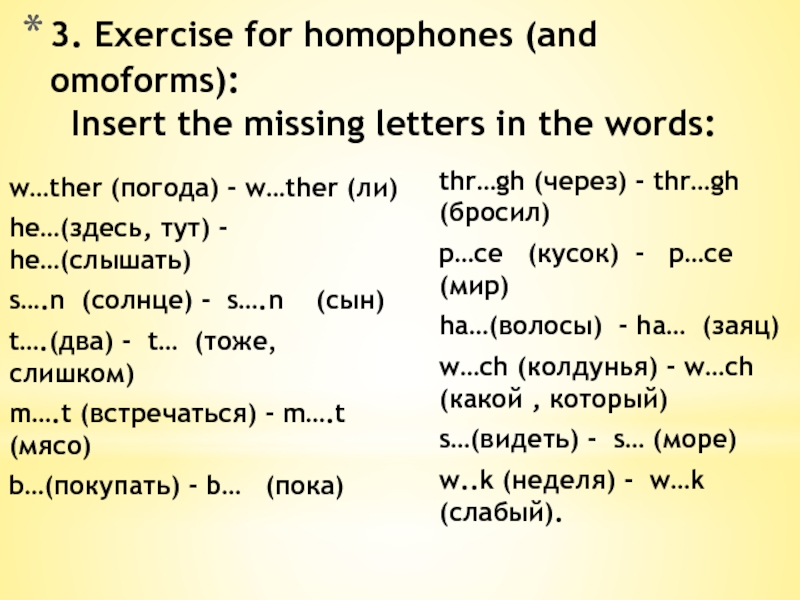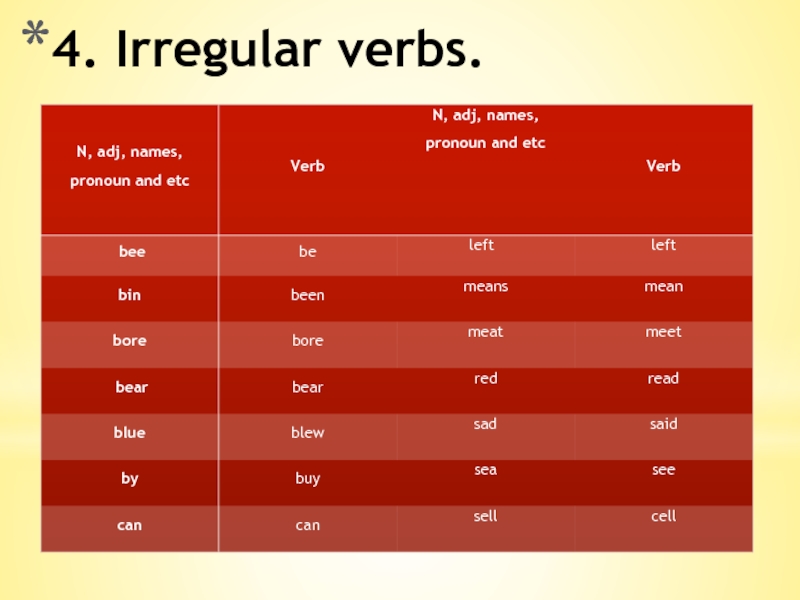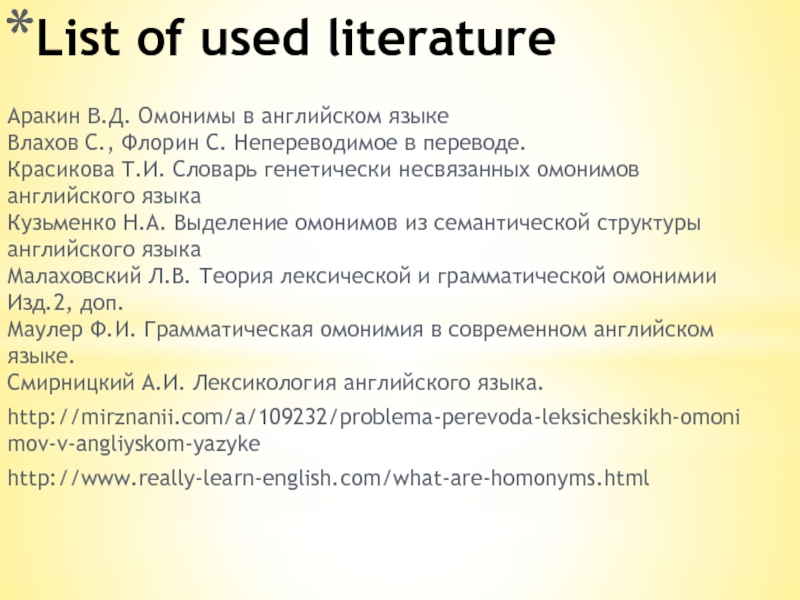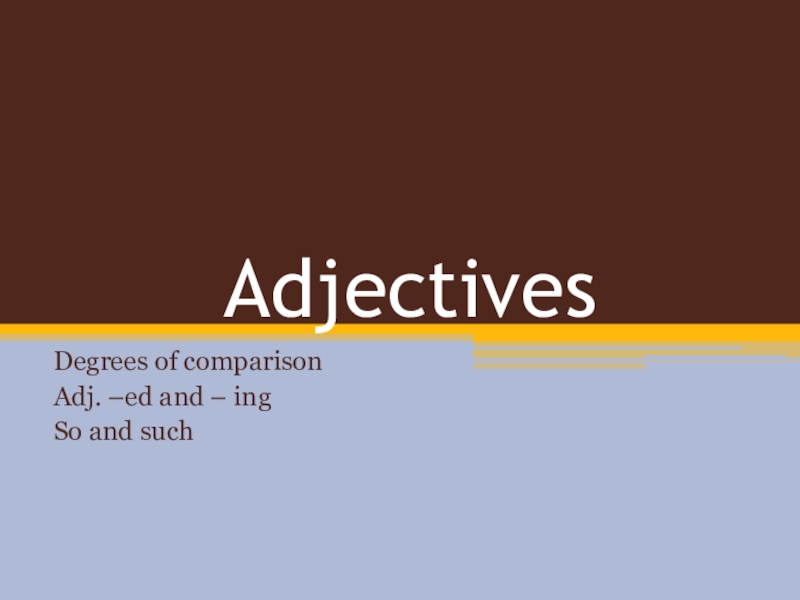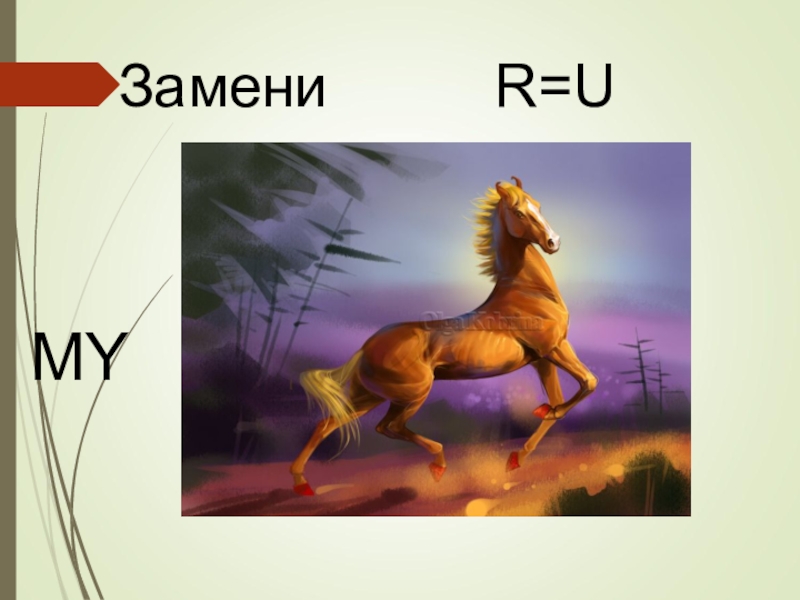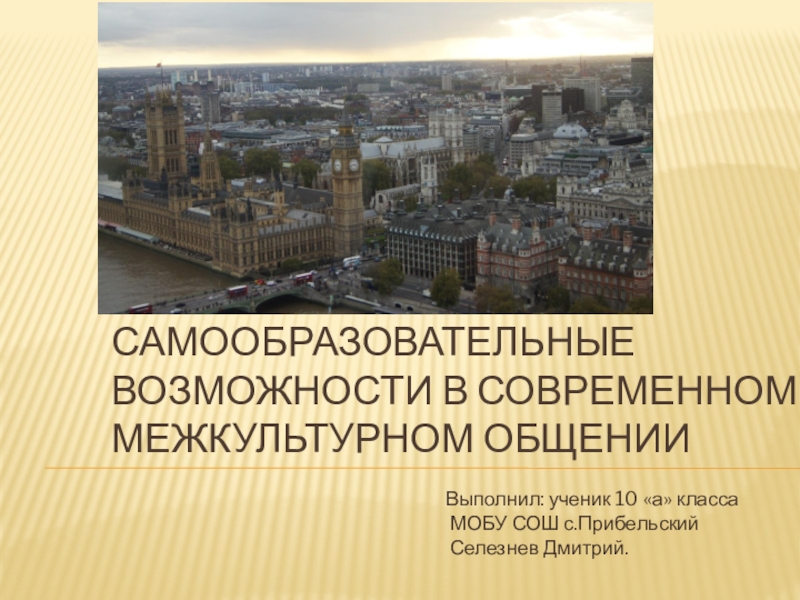- Главная
- Разное
- Образование
- Спорт
- Естествознание
- Природоведение
- Религиоведение
- Французский язык
- Черчение
- Английский язык
- Астрономия
- Алгебра
- Биология
- География
- Геометрия
- Детские презентации
- Информатика
- История
- Литература
- Математика
- Музыка
- МХК
- Немецкий язык
- ОБЖ
- Обществознание
- Окружающий мир
- Педагогика
- Русский язык
- Технология
- Физика
- Философия
- Химия
- Шаблоны, фоны, картинки для презентаций
- Экология
- Экономика
Презентация, доклад Homonymy in English
Содержание
- 1. Презентация Homonymy in English
- 2. TailTale"Mine is a long and sad tale!"
- 3. ● To clarify the meaning of the
- 4. Charles Bally (4 February 1865 – 10
- 5. HomophonesHomographsClassification of homonyms
- 6. In general, there are logically possible 9
- 7. ● Homophones purely lexical (fair (n) «ярмарка»
- 8. Complete homonyms (ear (n) (pl ears) «ухо»
- 9. ●pedlar/peddler [‘p e d l ə] (n)
- 10. Homonymous constructionShe called him a taxi –
- 11. The main ways of the origin of
- 12. sunu (сын) и sunne (солнце) ear (колос) и ear (ухо) yerd (двор) и yerde (жердь)
- 13. vail = veil, vain = vein,
- 14. “Homonymy serves the good of the speakers”
- 15. Lewis CarrollWilliam ShakespeareExamples of homonyms in the literature
- 16. "I had not!" cried the Mouse, sharply
- 17. …The canker-blooms have full as deep a
- 18. The hardest sentences were:●I accept everything except
- 19. 1. Crossword "OMOMHONES" In this crossword puzzle
- 20. Слайд 20
- 21. Rhiet - terhe (their - there)Eerd –
- 22. w…ther (погода) - w…ther (ли)he…(здесь, тут) -
- 23. 4. Irregular verbs.
- 24. Слайд 24
- 25. List of used literature Аракин В.Д. Омонимы
Слайд 1 Made by: O. Pokrovskaya
Teacher of English
Grammar school №13
Novosibirsk
Homonyms in
Слайд 2Tail
Tale
"Mine is a long and sad tale!" said the Mouse, turning
Слайд 3● To clarify the meaning of the word “homonymy” ● To study
Tasks:
●Familiarize myself with homonymy and see how we can use different exercises with homonyms at the lessons for our student to know and understand the English language better.
Слайд 4Charles Bally (4 February 1865 – 10 April 1947) was a
Lev Malakhovsky (8 May 1921 – 7 May 2003) Soviet and Russian linguist, doctor of philology, lexicologist and lexicographer
Definitions of homonyms
Слайд 6In general, there are logically possible 9 types of homonymous classes:
●
● Phonetics - graphic purely grammatical (milk (n) «молоко» and milk (v) «доить») ● Lexical and gramophone homophones (bear (n) «медведь» and bare (a) «обнаженный») ● Homophones are purely grammatical (practice (n) «практика» and practice (v) «практиковаться»)
Слайд 7● Homophones purely lexical (fair (n) «ярмарка» and fare (n) «плата
● Lexico-grammatical homographs (tear (n) [t I ə] «слеза» and tear (v) [t ɛ ə] «рвать») ● Homographs are purely grammatical (use (n) [j u: s] «польза» and use (v) [j u: z] «использовать»)
Слайд 8Complete homonyms (ear (n) (pl ears) «ухо» and ear (n) (pl
Partial homonyms (die (n) (pl dies) «штамп» and die (n) (pl ears) «игральная кость»)
Слайд 9●pedlar/peddler [‘p e d l ə] (n) «разносчик» ●postpone [p o u
Слайд 10Homonymous construction
She called him a taxi – She called him a
They are reading – They are interesting.
He made him a hero – He made him a sandwich
Слайд 11The main ways of the origin of homonyms
The conditions for the
In this case, new meanings can arise on the basis of the same source, for example, the meaning of a word hand – «лапа», «сторона», «власть», «работник», «умение», «почерк», «стрелка» etc., that goes back to the same true value «рука», and can develop one by one.
The taken form may turn out to be new, not similar to any of the ones already available, but may coincidentally coincide with some word of the language (for example, the coincidence of the word reciprocated from the French word in the 17th century ball «бал», with the already existing word ball «мяч» of Scandinavian origin).
Слайд 13vail = veil, vain = vein, wait = weight, way =
wrick = rick wrung = rung wrack = rack wreck = reck write = right wrap = rap wring = ring
hour = our heir = air
Слайд 14“Homonymy serves the good of the speakers” – E. Buissans
“Homonymy contributes
Opinions concerning difficulty of learning English owing to homonymy
Слайд 16"I had not!" cried the Mouse, sharply and very angrily. "A
"Why, there they are!" said the King triumphantly, pointing to the tarts on the table. "Nothing can be clearer than that. Then again - "before she had this fit" - you never had fits, my dear, I think?" he said to the Queen… "Then the words dont fit you", said the King… (Омонимы fit - приступ и fit - годиться).
"Well? It isn’t picked at all", Alice explained: "Its ground - " "How many acres of ground?" said the White Queen. (Омонимы ground - молотый, молоченный и ground - земля).
Слайд 17…The canker-blooms have full as deep a dye…//…Die to themselves. Sweet
…How with this rage shall beauty hold a plea,…(LXV)//Tired with all these, for restful death I cry… (LXVI)
…For that sweet odour which doth in a live…(LIV)//…Save that, to die, I leave my love alone…(LXVI)
…Thou by thy dial’s shady stealth mayst know…(LXXVII)//…O, no! it is an ever-fixed mark…(CXVI)
Слайд 18The hardest sentences were:
●I accept everything except spiders.
●My feet became wet
Dictation
Слайд 191. Crossword "OMOMHONES" In this crossword puzzle you need to find the
Слайд 21Rhiet - terhe (their - there)
Eerd – adre (deer - dear)
Lati-atel
Afer – irfa (fare - fair)
Rewit - tgirh (write - right)
Iar – eihr (air - heir)
Rybre - ruby (berry - bury)
Dowo - wudlo (wood - would)
2. Exercise in the form of a game - arrange the letters so that the homophones are:
Слайд 22w…ther (погода) - w…ther (ли)
he…(здесь, тут) - he…(слышать)
s….n (солнце) - s….n
t….(два) - t… (тоже, слишком)
m….t (встречаться) - m….t (мясо)
b…(покупать) - b… (пока)
thr…gh (через) - thr…gh (бросил)
p…ce (кусок) - p…ce (мир)
ha…(волосы) - ha… (заяц)
w…ch (колдунья) - w…ch (какой , который)
s…(видеть) - s… (море)
w..k (неделя) - w…k (слабый).
3. Exercise for homophones (and omoforms):
Insert the missing letters in the words:
Слайд 25List of used literature
Аракин В.Д. Омонимы в английском языке
Влахов С.,
http://mirznanii.com/a/109232/problema-perevoda-leksicheskikh-omonimov-v-angliyskom-yazyke
http://www.really-learn-english.com/what-are-homonyms.html
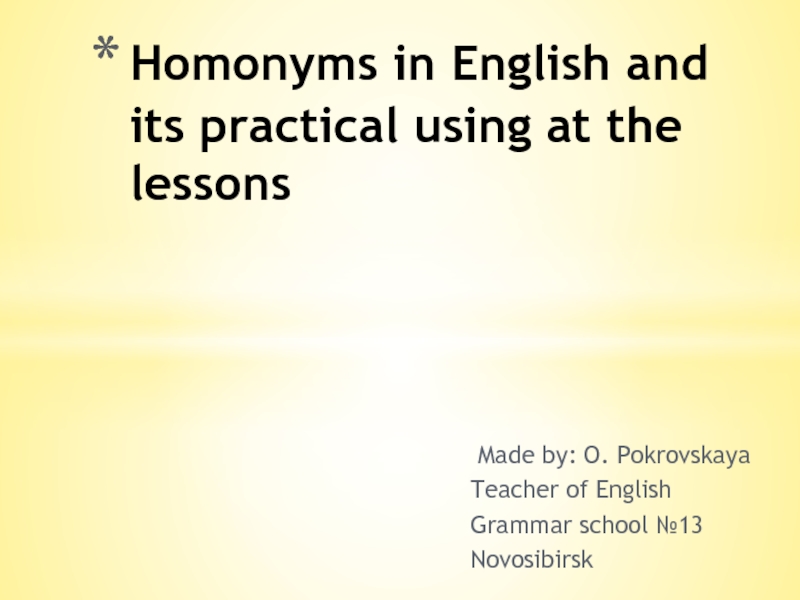
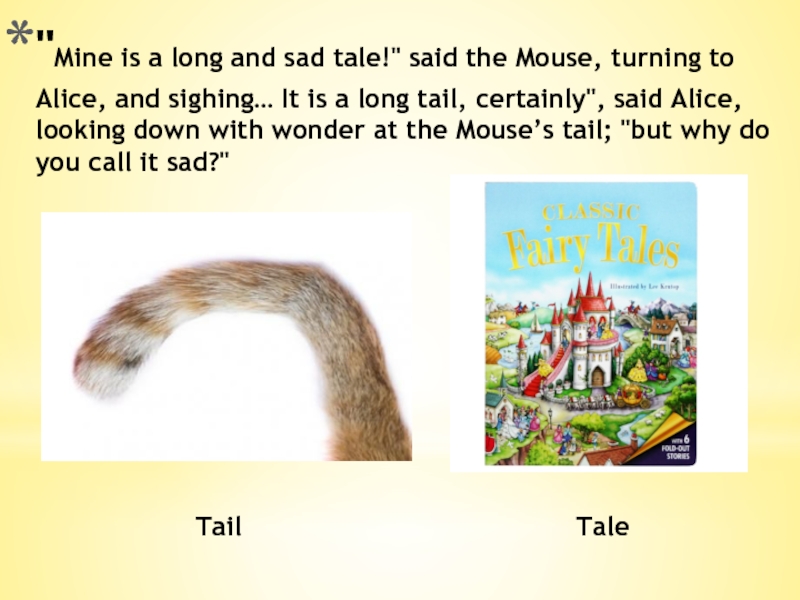
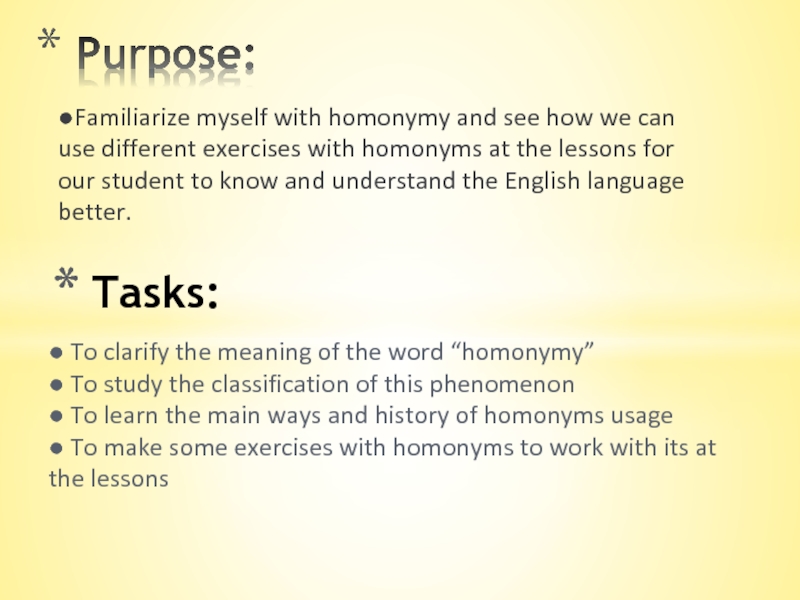

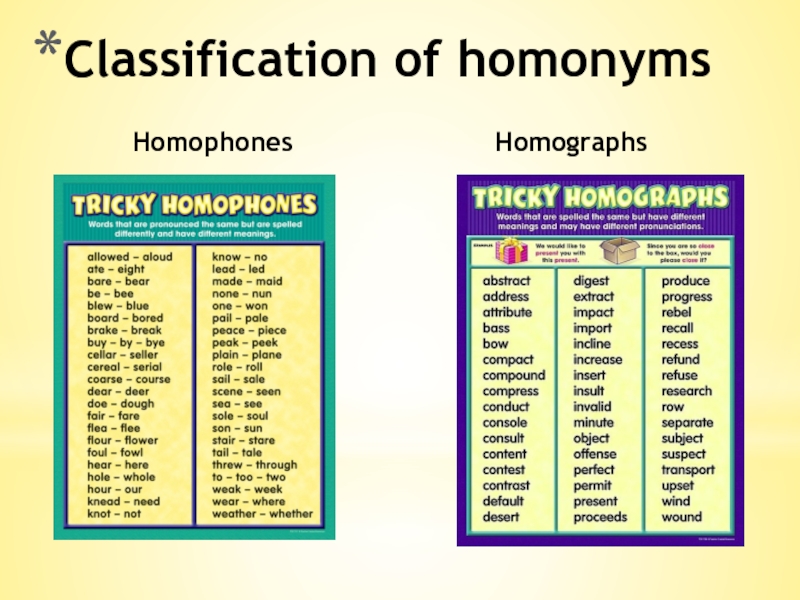
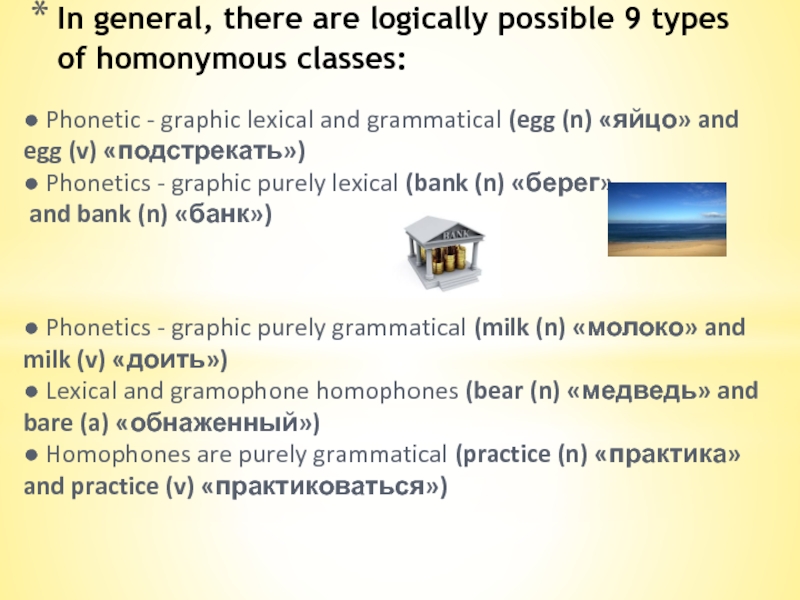
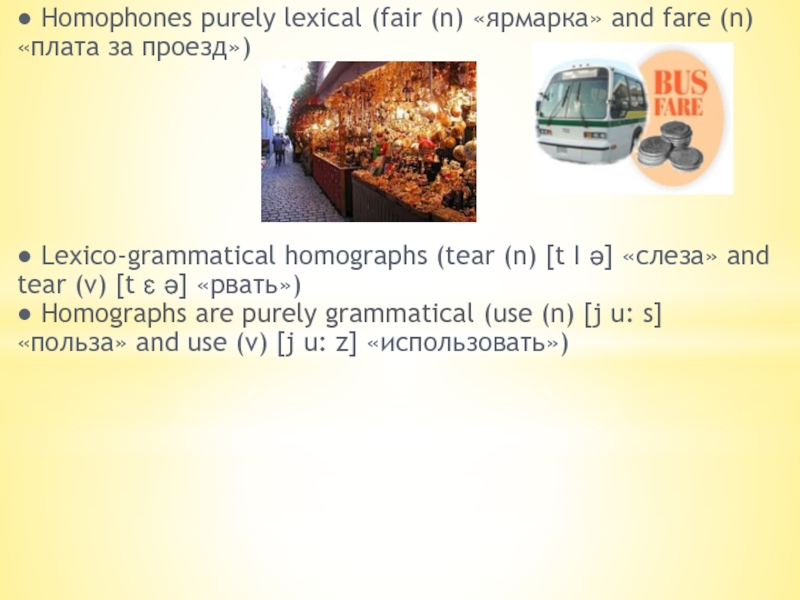

![Презентация Homonymy in English ●pedlar/peddler [‘p e d l ə] (n) «разносчик» ●postpone [p o ●pedlar/peddler [‘p e d l ə] (n) «разносчик» ●postpone [p o u s t’p o u n/](/img/thumbs/3a9f5517010e85275038c748a6602d3d-800x.jpg)

